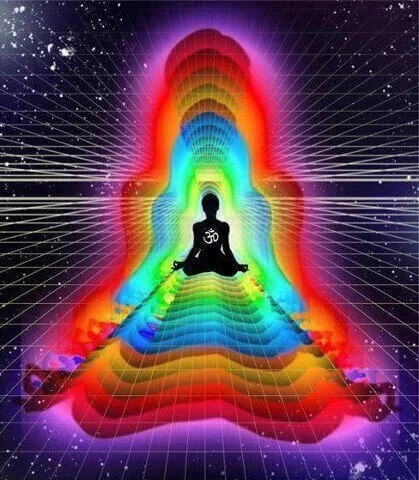Kundalini Yoga: A Beginner's Guide - Everything You Need to Know
Kundalini Yoga at first glance seems like a cult—everyone is dressed in white wearing turbans covering their head, doing strange movements and chanting ancient mantras in another language. It can be enough to put off even the most “woo woo” of us.
I was apprehensive at first. What kind of weird yoga was this? There were no downward dogs or sun salutations. I would work up a sweat much quicker than hot yoga. We would hold poses for an excruciatingly long time—much longer than yin — which would bring to surface intense emotions that made me want to get up and close the door on Kundalini Yoga for good.
But I would leave each class feeling clearer, stronger, and more connected to myself. Life began to show up differently. I started to drop compulsive thoughts and habits which didn’t serve my highest self.
I decided there had to be something here worth exploring. So I kept coming back for more.
WTF is Kundalini?
Kundalini is an ancient Indian Sanskrit term—meaning “coiled snake”— which refers to an energy which sits coiled at the base of the spine. This is considered our life force energy, our ultimate creative potential. It is symbolized with two snakes wrapping around each other up the spine (think of the caduceus in western medicine), which moves up and through each of the seven chakras in the body.
The goal is to awaken the Kundalini, allowing us to increase our creative capacity and access the highest of our human potential. It’s a process of self-actualization and could be likened to experiencing enlightenment.
By awakening the Kundalini energy, we align with our higher selves and transform our fate into destiny—aka, we are no longer victims of life and begin to consciously co-create with the universe.
Most of us have this energy laying dormant. It may arise spontaneously in response to life events, catching us completely off guard. In this case, it can be a radical adjustment in which you’re unprepared for (a lot of the “crazy” Kundalini rising symptoms occurs unexpectedly).
Conversely, you can consciously and incrementally awaken Kundalini over time through spiritual practices. When it happens through the latter instance, the body is considered more prepared, thus the Kundalini energy can rise smoothly from the base of the spine (first chakra) all the way up to and out of the crown chakra, minus the wild side-effects.
The knowledge of Kundalini energy has been around for thousands of years, first mentioned in the Upanishads as a science of energy and spiritual philosophy, and then referred to in various spiritual lineages spanning from Hatha, Kabbalah, Tantra, to Taoism.
The objective of many types of spiritual practices is to awaken the Kundalini energy, with some methods working faster than others. Enter in, Kundalini Yoga.
Let's Talk Kundalini Yoga
Kundalini Yoga is considered the “yoga of awareness.” For thousands of years, the practices were kept secret, orally passed down from master to student, often remaining within royal lineages and those in positions of power.
The practices were hidden because it was believed they would give practitioners great powers and gifts, thus it was forbidden to spread this knowledge amongst the masses out of fear it would land in the wrong hands.
Kundalini Yoga would have remained secret if it were not for a traveling yogi, Yogi Bhajan*, came to the west in the 1960s. In the midst of the counter-cultural revolution, Yogi Bhajan began teaching Kundalini Yoga classes and hosting teacher-level trainings for anyone to attend.
Since then, Kundalini Yoga has remained somewhat on the fringe compared to mainstream branches of yoga such as Hatha or Vinyasa. But in recent years, it has been gaining popularity with an increasing number of studios opening up and a new generation of teachers revitalizing the practices with relevance to the demands of modern culture.
A Kundalini Yoga class or personal practice has three main components: mantra, pranayam, and kriyas.
1. Mantra
Mantra is described as the “science of sound” and a “quantum technology” in Kundalini Yoga. It is not the same as affirmations, although mantras are also designed to be repeated out loud. Rather, each mantra is encoded with a particular vibratory frequency, that when chanted out loud or silently changes the brain patterns to vibrate with that particular frequency.
Sounds too esoteric for you? Science has shown that everything has a resonant frequency, which is the natural frequency at which something vibrates. If an opera singer is able to shatter glass when their voice reaches a certain pitch or frequency, then it could be said that chanting or listening to mantra, which is encoded with a particular sound current, will affect our vibration on a cellular level.
Mantras in Kundalini Yoga are in an ancient Sikh language called Gurmukhi. You don’t have to understand the mantra on a literal level for it to have an effect on you. In fact, it is probably more effective, as our minds cannot layer meaning onto the words via our conscious understanding of language. Instead, it goes straight into the subconscious mind, cleansing and clearing out habitual thought patterns and subconscious junk we don’t need.
If you’re interested in learning more about mantra, I highly recommend reading The Quantum Technology of The Shabd Guru (although be warned, it is quite dense).
2. Pranayam
Pranayam or breath control is a central component to Kundalini Yoga. Oui, We has actually just posted an entire article on pranayam, but here’s a short recap.
Pranayam is considered the “science of breath,” which is a form of energy management to manage different energy states of health, consciousness, and emotion. Mastery over one’s breath can give mastery over one’s life.
The ability to consciously control your breath will allow you to move through challenging situations with grace.
Many of Kundalini Yoga postures, or “kriyas” (more on that next), are prescribed with a certain breathing technique to maximize the benefits of that particular movement. But pranayam is just as powerful practiced on its own.
There are many different types of pranayam in Kundalini Yoga — some specifically reduce stress levels, others increase energy, whilst other techniques are designed to increase your breath capacity.
Another fun fact about pranayam: apparently, this is what gives you the “Kundalini glow,” which should be enough to want to dip your toes in (the beauty hook was enough for me).
3. Kriyas
A kriya is considered a sequence of postures, breath, and sound that are integrated together which alter the state of the body (and subsequently your experience of life). Kriyas are both exercise and meditation, which physically, emotionally, and mentally alter your experiential state.
There are thousands of different kriyas in Kundalini Yoga, all designed to remove certain blocks, blindments, and negative manifestations of the ego. Certain kriyas are often prescribed for different challenges and subconscious patterns, which when repeated over time will establish new patterns and ways of relating in the body.
Kriyas can range from simple and rejuvenating, to hard and uncomfortable. Depending on the specific chakra or “body” (Kundalini Yogic philosophy says we have 10 bodies) the kriya works on, certain emotions or thought patterns will surface in order to be released.
What I believe differentiates Kundalini Yoga as a tool for working through subconscious patterns is that you do not have to go into the problem by consciously speaking about it out loud or relieve the negative experience for it to be healed.
From my own perspective, Kundalini Yoga automatically allows you to “drop” these patterns, to the point where you almost forget they ever existed; they melt away without you having to do any conscious “work” at all. Kundalini Yoga works through these patterns somatically (where they are encoded in the body) and thus bypasses the conscious and intellectual mind completely.
Common Questions
Q. Okay sounds great, but do I have to wear white and cover my head with a turban?
Nope, there’s no requirement for you to do these if you don’t want to. In fact, Kundalini Yoga doesn’t have any rules, as it is not a religion or set of dogmatic beliefs. The only “rule” in Kundalini Yoga is to follow the set kriya sequences in the way they have been taught.
The reason why people wear white is because it supposedly enhances and brightens the state of your aura, which may have some effect whilst practicing. It is simply a personal preference—personally, I do not wear all white and sometimes even wear all black (I’m a rebel at heart).
The reason why people may wear a turban or scarf to cover their heads is because when the Kundalini rises, it shoots up to the crown chakra and can escape through the top of the head. Wearing something that covers the head can keep the energy contained in the body, and may help you to feel more grounded and centred.
Sometimes, we can get a bit up in the clouds, or a ‘Kundalini high’, whilst practicing. Experiment for yourself: if you tend to get dizzy and light-headed during practice, you might want to consider covering your head.
Q. Why do I have to practice a certain meditation or kriya for 40 days? Can I be more sporadic with my practice?
Kundalini meditations or kriyas are commonly prescribed to be practiced for 40 days. The reasoning is that it takes about 40 days to change a habit. Often it is recommended you practice even longer than 40 days, to further integrate this new way of being.
You could look at it as a commitment to yourself. To show up everyday to do a kriya or meditation, no matter what external challenges and situations surround you, will subconsciously signify your devotion to your highest self. Everyday may be different, but your practice can help you ground down and anchor yourself into every experience.
Again, there are no rules in Kundalini Yoga! You could practice as little or as often as you like. But real change happens through consistency over time. Experiment for yourself and find a sustainable routine that works—and if you do try to commit to 40 days and slip off the wagon, the most important thing is to not place any guilt or shame on yourself.
At the end of the day, a spiritual practice should always be rooted in love and respect for yourself; there is no need to add extra stress on top of everything else going on in your life.
Q. I would love to try Kundalini Yoga, but I’m overwhelmed and have no idea where to start. Help?!
There’s so much dense information packed into the technology of Kundalini Yoga. With so many kriyas and meditations to choose from, it can be totally disorienting with where on earth to start!
I would first consider checking out a studio near you, as having a teacher guide you through a class will help you to understand the experience of Kundalini Yoga, and how to correctly perform certain kriyas/meditations. The next best option would be to try an online class.
Experience it yourself
One of the most important paradigmatic shifts of the Aquarian Age is the shift from a theoretical understanding of knowledge to knowledge that is embodied in experience.
Kundalini Yoga is very much a part of this shift. You could read about Kundalini all you want—and if you’re a nerd like me, you may love geeking out on it—but the real magic happens in the experience of the practice itself.
*This article acknowledges the recent allegations placed against Yogi Bhajan and does not seek to idealize him or ignore the real experiences of victims. It is simply sharing the origins of how Kundalini Yoga (KY) came to the west and what the practice entails. It therefore aims to separate the practice of KY from the teacher, focusing on the practice of KY itself.
Chiara Christian is a writer, gemini and curious traveler. She can be found exploring local book shops or going for a dip in the ocean. You can follow her meanderings @chiara_liane.





